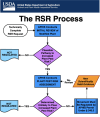The Purple Tomato Story; From Laboratory Bench to the Consumer
- PMID: 39840404
- PMCID: PMC11744742
- DOI: 10.1021/acsfoodscitech.4c00692
The Purple Tomato Story; From Laboratory Bench to the Consumer
Abstract
A world apart from academic research, the path from developing a polyphenol-rich crop to a product available to consumers is not one taken by many research scientists. Here we review the steps taken to commercialize anthocyanin-enriched purple tomatoes in the USA. In describing some of the difficulties encountered and the work that was necessary for a successful commercial launch of a new biotech product, we hope to encourage others to believe that there is a viable route to market, and an appetite for polyphenol-enriched foods that can protect health.
© 2024 The Authors. Published by American Chemical Society.
Conflict of interest statement
The authors declare the following competing financial interest(s): C.M. is a director of Norfolk Plant Sciences Ltd, the spin out company that applied for USDA/APHIS approval for commercialization and FDA notification of the Purple Tomato trait described in this review.
Figures







Similar articles
-
Comparison of the Peel-Associated Epiphytic Bacteria of Anthocyanin-Rich "Sun Black" and Wild-Type Tomatoes under Organic and Conventional Farming.Microorganisms. 2022 Nov 12;10(11):2240. doi: 10.3390/microorganisms10112240. Microorganisms. 2022. PMID: 36422310 Free PMC article.
-
Rising Demand for Healthy Foods-Anthocyanin Biofortified Colored Wheat Is a New Research Trend.Front Nutr. 2022 May 9;9:878221. doi: 10.3389/fnut.2022.878221. eCollection 2022. Front Nutr. 2022. PMID: 35634383 Free PMC article. Review.
-
Consumer sensory analysis of high flavonoid transgenic tomatoes.J Food Sci. 2014 Jun;79(6):S1212-7. doi: 10.1111/1750-3841.12478. Epub 2014 May 16. J Food Sci. 2014. PMID: 24837183
-
Changes in flavonoid and carotenoid profiles alter volatile organic compounds in purple and orange cherry tomatoes obtained by allele introgression.J Sci Food Agric. 2020 Mar 15;100(4):1662-1670. doi: 10.1002/jsfa.10180. Epub 2020 Jan 10. J Sci Food Agric. 2020. PMID: 31808163
-
The Potential of High-Anthocyanin Purple Rice as a Functional Ingredient in Human Health.Antioxidants (Basel). 2021 May 24;10(6):833. doi: 10.3390/antiox10060833. Antioxidants (Basel). 2021. PMID: 34073767 Free PMC article. Review.
Cited by
-
Plant synthetic biology-based biofortification, strategies and recent progresses.J Integr Plant Biol. 2025 Aug;67(8):1997-2004. doi: 10.1111/jipb.13934. Epub 2025 May 16. J Integr Plant Biol. 2025. PMID: 40376763 Free PMC article. Review.
-
How to eat an idea-A roadmap for translation and impact in plant biology.Plant Physiol. 2025 Jul 3;198(3):kiaf178. doi: 10.1093/plphys/kiaf178. Plant Physiol. 2025. PMID: 40317192 Free PMC article. No abstract available.
-
A timeline of discovery and innovation in Arabidopsis.Plant Cell. 2025 May 9;37(5):koaf108. doi: 10.1093/plcell/koaf108. Plant Cell. 2025. PMID: 40324413 Free PMC article. No abstract available.
References
-
- Butelli E.; Titta L.; Giorgio M.; Mock H. P.; Matros A.; Peterek S.; Schijlen E. G.; Hall R. D.; Bovy A. G.; Luo J.; Martin C. Enrichment of tomato fruit with health-promoting anthocyanins by expression of select transcription factors. Nature biotechnology 2008, 26, 1301–1308. 10.1038/nbt.1506. - DOI - PubMed
Publication types
LinkOut - more resources
Full Text Sources
